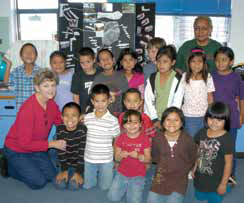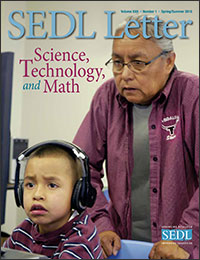On the Road With Technology
The roads are lonely. The land stretches out for miles on end, some of it flat and open, some high desert broken only by occasional peaks. The towns are small and isolated—separated by vast ranches and reservations. In this remote, rural region of western New Mexico, students and teachers travel great distances to reach the nearest school. But with SEDL’s help, four districts in the region are using technology to connect schools and students to each other and the larger world through the New Mexico Rural Partnership for Technology.
A Road Map for Using Technology
The partnership aims to integrate technology into instruction to build students’ 21st century skills, with a focus on literacy. Using technology in classroom instruction can help boost student achievement in core content areas like reading, writing, math, and science. The benefits are not limited to academics, however. Through the use of technology, students are likely to improve problem-solving skills and enjoy higher motivation and a better attitude about learning (Waddoups, 2004).
SEDL has been providing professional development and follow-up technical assistance to help teachers understand the role of technology and use it effectively in the classroom. The results are already evident, with students using technology for self-expression, problem solving, and even world exploration.
Telling Stories
One of the first professional development sessions that SEDL staff provided to teachers was on digital slide shows. Teachers learned to use applications like Microsoft® Photo Story, which enables users to create customized slideshows with digital photos. After mastering the software, teachers learned how to use digital slideshows to support literacy and writing in a creative, project-based way. Most teachers found that they could quickly and easily learn the application.
By starting off with a simple activity, teachers and students enjoyed a quick win that built confidence and encouraged them to find additional ways to incorporate technology. Students are now taking pictures with digital cameras, writing and narrating stories, and then putting slides in order to tell their stories. Because many of the students are English language learners, digital slide shows provide an effective and engaging way for them to improve their communication skills.
Traveling the World
Virtual field trips were the focus of another professional development session. In rural New Mexico, students travel up to 70 miles one way to attend school. Activities like online trips to museums in Paris can reduce isolation, open the world to students, and help them understand their place in it. Using videoconferencing technology, SEDL staff conducted the session remotely, from SEDL headquarters in Austin, Texas, while teachers participated at their individual school sites.

Students at Magdalena Elementary School, one of the schools participating in the New Mexico Rural Partnership for Technology
During the session, teachers visited a series of Web sites that provide virtual field trips. Excursions ranged from clicking through the hallways of the Louvre to using videoconferencing capabilities to interact with others. Jim Sauer, a teacher at Magdalena Elementary, and his fifth-grade students participated in a virtual field trip with NASA on aerodynamics. They joined students from across the country as experts in Florida provided an online demonstration and then answered questions. “My kids did not know where Florida was before this— and now they [are] interacting with other kids who live in Florida,” says Sauer. “This gave them a real sense of where they are geographically.”
Solving Problems
Some of SEDL’s professional development sessions showed teachers how to use technology more effectively. Teachers at Quemado Independent School District, one of the participating districts, already had access to interactive whiteboards. These tools can be used for a variety of instructional activities: displaying Web sites, running educational software, or giving multimedia presentations. Moreover, they can be connected to a projector, allowing students to use them for group activities and to improve language and presentation skills.
Teachers were unsure how to integrate the interactive whiteboards into their lessons, however; so SEDL provided professional development showing them ways to use the equipment. “I don’t even know what I would do now without them—my camera, my projector, my whiteboard,” says Tracy Williams, a Quemado teacher. “There are so many things I can do with them that keep the kids interested.”
Support for Going the Distance
SEDL staff are now focusing on providing follow-up technical assistance. They have visited teachers in their classrooms, answered questions, and helped them find resources and troubleshoot problems. They have also provided guidance on additional ways to integrate technology beyond what was provided during formal professional development sessions.
One of these follow-up sessions was billed as, “Bring me your problems, and we’ll find a solution.” For example, one teacher said she had a cart full of AlphaSmarts, portable word-processing devices similar to laptops, that had been sitting in her classroom for several years. No one at the school knew how to use them. SEDL staff helped the teacher get the AlphaSmarts working and then taught her how to use them to enhance teaching and learning. The teacher now provides a setting where each student can use a device to write stories and then, using wireless technology, send the stories to a classroom printer. With SEDL’s support, the teacher learned a new way to integrate technology to improve students’ literacy skills.
The four districts, by partnering with one another and with SEDL, are investing in technology tools and professional development to ensure that students, though isolated in rural areas, learn the skills they need for the 21st century. Teachers and students in the districts are proud of what they have accomplished. Several schools are planning technology nights for parents and the community to spotlight students’ work. And the districts are already planning future technology projects.
In western New Mexico, the roads may be lonely and the schools may be isolated, but educators and students are now connected to people, places, and information from around the world. They still have a distance to go, but the districts in the partnership have come a long way in using technology to improve students’ literacy skills and understanding of the world.
Reference
- Waddoups, G. L. (2004). Technology integration, curriculum, and student achievement: A review of scientifically based research and implications for EasyTech. Portland, OR: Learning.com.

Next Article: MyMoon: Engaging a New Generation in Lunar Science and Exploration

